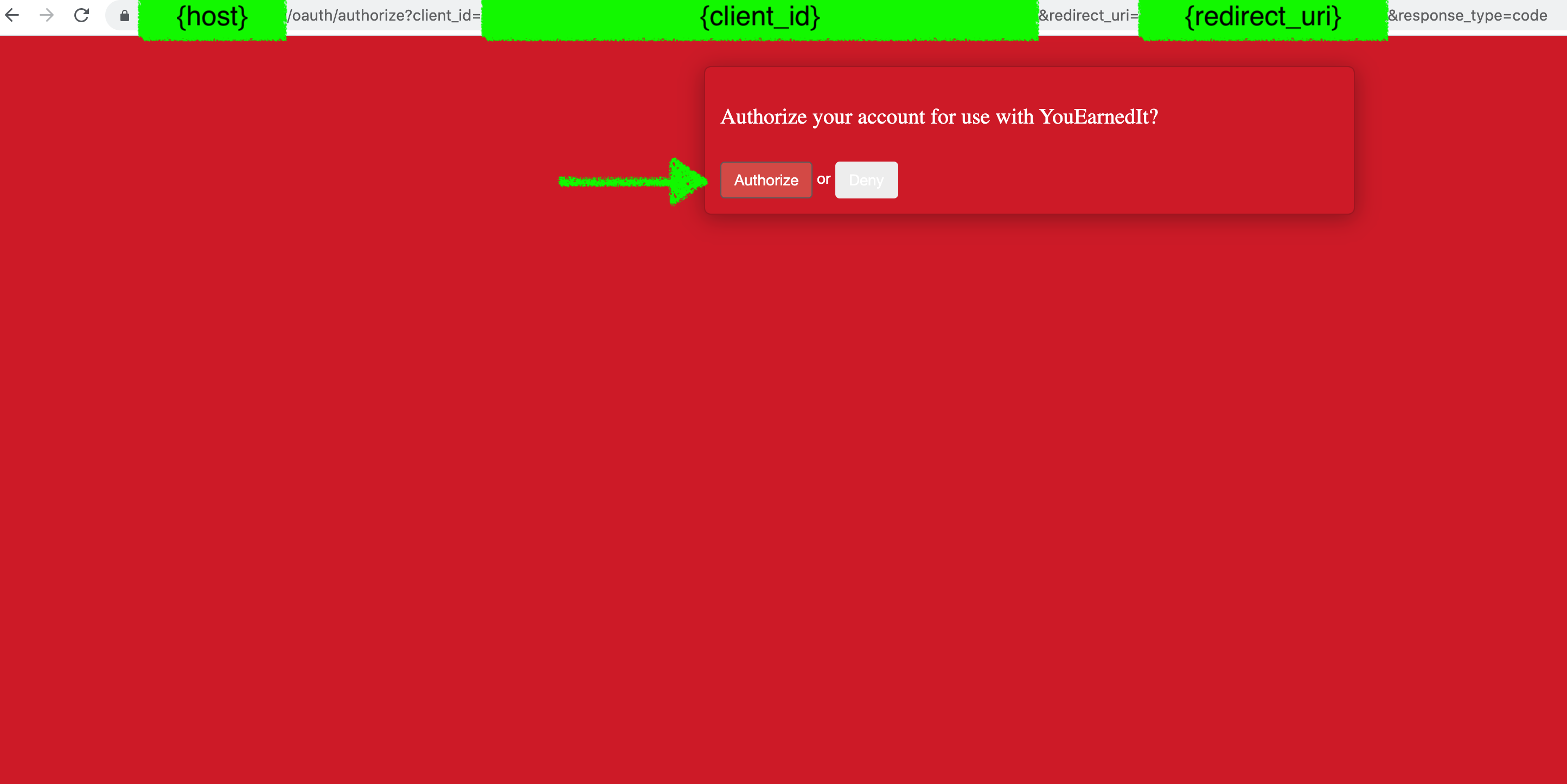Optional Implementation - API Development
Legacy Rewards & Recognition API Development
There are two versions of the Legacy Rewards & Recognition API offered: Version 2 and Version 3. We advise using Version 3 endpoints over Version 2 endpoints whenever possible. All requests must be made over HTTPS.
Please contact your account manager for API enablement and an OAuth 2.0 client_id and client_secret. A redirect_uri for OAuth 2.0 must be provided to your account manager and must begin with https://.
API Host
All API requests will include a host. The host will vary for all customers and depends on the environment and subdomain.
| Environment | Host |
|---|---|
| Production | {subdomain}.youearnedit.com |
| Demo | {subdomain}.rr.cs-demo.non-prod.kazoohr.io |
API Authentication
All requests to API endpoints will use a bearer token retrieved using the OAuth 2.0 Authorization Code Grant protocol. The bearer token will be limited in authorization scope by the permissions of the authenticated user completing the authorization request. Follow the steps below to retrieve a bearer token.
Step 1: Authorization Request
Open a web browser of your choice and log in to your KazooHR environment.
In the browser where you have successfully authenticated, make a GET request to your Authorization URL. This url will be different for each customer, depending on three variables.
Authorization URL: https://{host}/oauth/authorize?client_id={client_id}&redirect_uri={redirect_uri}&response_type=code
host- see API Host section above- For Example: a customer with the subdomain “example” that is connecting to the production environment will use the host example.youearnedit.com
client_id- this value is provided by your KazooHR account manager- For Example: the client id will be be a string such as f0cdc5035bb3f41e271315546817fd7941fbeb69307330fefd222c3c5f513556
redirect_uri- this value is provided by the customer to the KazooHR account manager; this is where theauthorization_codewill be delivered- For Example: a customer may have provided a value such as https://example.com/auth/callback
After making the request to your Authorization URL, you will be prompted to “Authorize your account for use with YouEarnedIt?”. Click “Authorize” to continue.

After clicking “Authorize”, a GET request will be made to your redirect_uri. This request will contain an authorization_code in the query string: ?code={authorization_code}. This authorization_code will be necessary for the next step.
Step 2: Token Request
Using an API client such as Postman, make a POST request to your Token URL. This url will be different for each customer, depending on five variables.
Token URL: https://{host}/oauth/token?grant_type=authorization_code&scope=API&code={code}&client_id={client_id}&client_secret={client_secret}&redirect_uri={redirect_uri}
host- see API Host section abovecode- this value is provided in the query string of a GET request to yourredirect_uri; this request is made in response to your authorization requestclient_id- this value is provided by your KazooHR account managerclient_secret- this value is provided by your KazooHR account managerredirect_uri- this value is provided by the customer to the KazooHR account manager; this is where theauthorization_codewas delivered
Sample Response Payload:
{
"access_token": "xxxxxxxxxxxxxxxxxxxxxxxxx",
"token_type": "Bearer",
"expires_in": 1209600,
"refresh_token": "xxxxxxxxxxxxxxxxxxxxxxxxx",
"created_at": 1627944485
}
You have now successfully retrieved an access_token that you may use as a bearer token for requests to the Version 2 and Version 3 endpoints detailed in the API Endpoints section below.
The access_token expires in 2 weeks. To retrieve a new access_token, repeat the API Authentication steps 1 and 2 or make a refresh token request.
Step 3: Refresh Token Request
Using an API client such as Postman, make a POST request to your Refresh Token URL. This url will be different for each customer, depending on two variables.
Refresh Token URL: https://{host}/oauth/token?grant_type=refresh_token&refresh_token={refresh_token}
host- see API Host section aboverefresh_token- this value is provided in the response payload of the Token URL request
Sample Response Payload:
{
"access_token": "xxxxxxxxxxxxxxxxxxxxxxxxx",
"token_type": "Bearer",
"expires_in": 1209600,
"refresh_token": "xxxxxxxxxxxxxxxxxxxxxxxxx",
"created_at": 1627944485
}
API Endpoints
Both the Version 2 and Version 3 API offer a variety of endpoints at two different base URLs. The host depends on the environment and subdomain (see API Host section above). Each version’s documentation provides a comprehensive list of endpoints offered.
| Version 2 | Version 3 | |
|---|---|---|
Base URL |
https://{host}/api/2/ |
https://{host}/api/v3/ |
Documentation |
Accessed here | Accessed by navigating to https://{host}/docs/v3.html |
Headers
All requests to API endpoints must include these headers:
Accept: application/json
Content-Type: application/json
Authorization: Bearer {access_token}
HTTP Status Codes
| Response Code | Description |
|---|---|
| 200 OK | Everything worked as expected. |
| 400 Bad Request 422 Unprocessable Entity |
Invalid request, probably missing or invalid parameter(s). |
| 401 Unauthorized | No valid credentials provided, or access token expired. |
| 404 Not Found | The requested item doesn’t exist. |
| 500 Internal Server Error 502 Bad Gateway 503 Service Unavailable 504 Gateway Timeout |
Something went wrong on our end. |
Paged Responses
Some responses (where indicated in the endpoints documentation) are paged. Such responses will be wrapped with paging information, along with a “data” property containing the requested data:
{
"page": 1,
"page_size": 25,
"page_count": 6,
"count": 150,
"data": [...]
}
API development and testing recommendation
We recommend that you complete all API testing with a demo environment before connecting to production.
External Resources
- Documentation: OAuth 2.0 Authorization Code Grant
- Video: OAuth 2.0: An Overview
